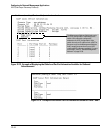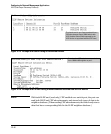
12-47
Configuring for Network Management Applications
LLDP (Link-Layer Discovery Protocol)
Displaying LLDP Statistics
LLDP statistics are available on both a global and a per-port levels. Rebooting
the switch resets the LLDP statistics counters to zero. Disabling the transmit
and/or receive capability on a port “freezes” the related port counters at their
current values.
Syntax show lldp info stats [ port-list ]
The global LLDP statistics command displays an overview of
neighbor detection activity on the switch, plus data on the
number of frames sent, received, and discarded per-port. The
per-port LLDP statistics command enhances the list of per-port
statistics provided by the global statistics command with some
additional per-port LLDP statistics.
Global LLDP Counters:
Neighbor Entries List Last Updated: Shows the elapsed time since
a neighbor was last added or deleted.
New Neighbor Entries Count: Shows the total of new LLDP
neighbors detected since the last switch reboot. Disconnecting,
then reconnecting a neighbor increments this counter.
Neighbor Entries Deleted Count: Shows the number of neighbor
deletions from the MIB for AgeOut Count and forced drops for
all ports. For example, if the admin status for port on a
neighbor device changes from tx_rx or txonly to disabled or
rxonly, then the neighbor device sends a “shutdown” packet out
the port and ceases transmitting LLDP frames out that port.
The device receiving the shutdown packet deletes all
information about the neighbor received on the applicable
inbound port and increments the counter .
Neighbor Entries Dropped Count: Shows the number of valid LLDP
neighbors the switch detected, but could not add. This can
occur, for example, when a new neighbor is detected when the
switch is already supporting the maximum number of
neighbors. Refer to “Neighbor Maximum” on page 12-50.
Neighbor Entries AgeOut Count: Shows the number of LLDP
neighbors dropped on all ports due to Time-to-Live expiring.
— Continued on the next page. —


















